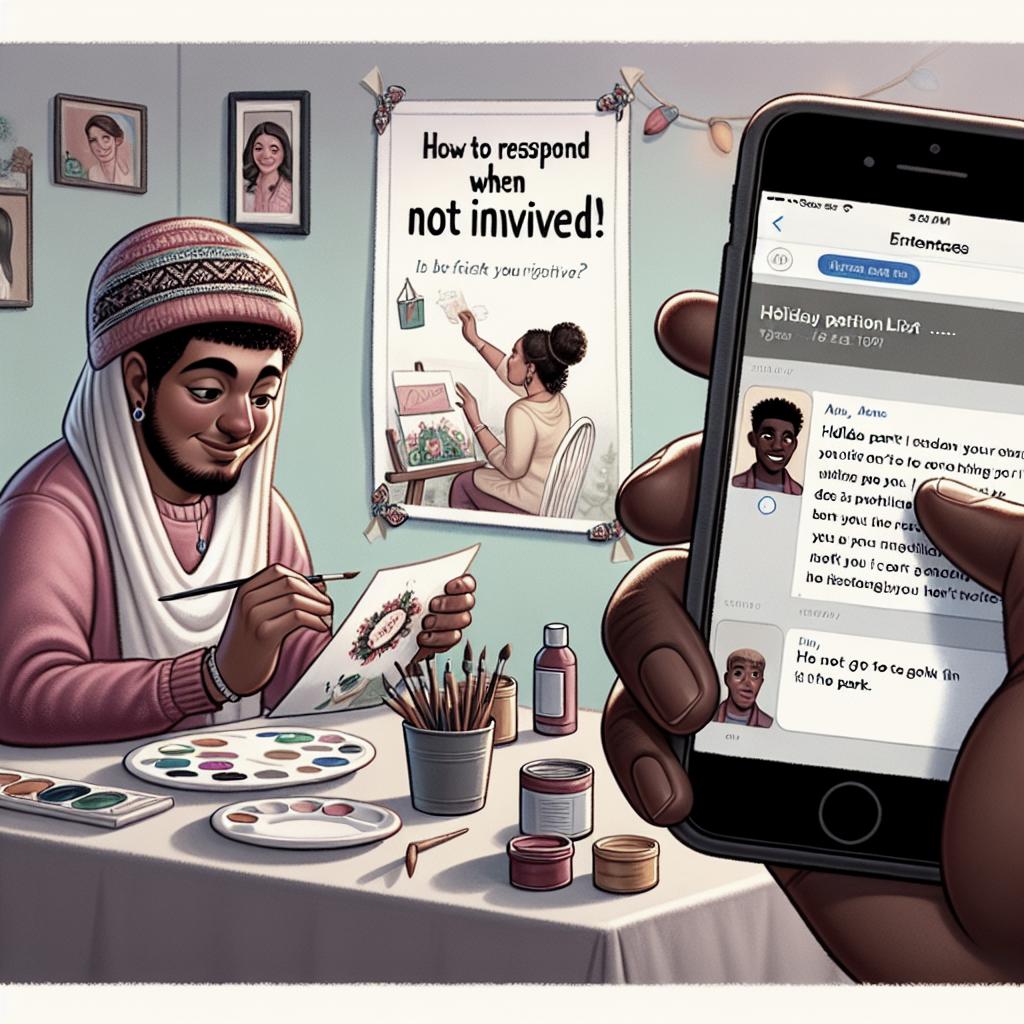It happens to the best of us: You find out about a gathering or an event that you weren’t invited to, and immediately, a tempest of emotions starts to brew. Being left out can sting, hitting various areas of our self-esteem and making us question our social connections. But this isn’t the end of the world. In this blog post, we’ll delve into some practical steps you can take to navigate the emotional landscape of not being invited. From validating your feelings to assessing your friendships, practicing self-care, and potentially seeking professional guidance, let’s break it down step-by-step to help you process the situation and come out stronger.
Step 1: Enjoy this sweet, sweet validation.
When you find out you weren’t invited to something, it can trigger an array of emotions, ranging from sadness to anger to confusion. The first step is to lean into those feelings. It’s perfectly okay to be upset about being left out. Validate your feelings instead of brushing them off or pretending they don’t exist. This validation is crucial; it tells you that your emotions are worth being acknowledged.
Consider talking to a trusted friend or writing down your feelings to help process the situation. The goal here is to let yourself feel the full spectrum of emotions without bottling them up. The healing process begins with acknowledging your hurt rather than ignoring it.
Step 2: Consider why you’re actually upset.
Take a moment to dig deeper into why being excluded bothers you. For some, it might feel like a personal rejection, whereas for others, it could trigger feelings of insecurity or remind them of past experiences of being left out. Understanding the root cause helps you address the issue more effectively.
When you identify the deeper reasons behind your upset, you can tackle them head-on instead of getting caught up in surface-level frustrations. This self-awareness allows you to address those underlying feelings, whether it’s seeking reassurance about your worth or addressing past traumas.
Step 3: Call out those mean voices in your head.
Once you’ve validated your feelings and understood why you’re upset, it’s time to address any negative self-talk. Those inner voices can be relentless, whispering things like “You’re not good enough” or “Nobody likes you.” Recognizing these thoughts for what they are – intrusive and unfounded – is crucial.
Challenge these negative thoughts by reminding yourself of your positive traits and the meaningful connections you do have. Battling negative self-talk isn’t easy, but it’s an important step toward maintaining a healthy self-esteem. Take control by turning self-criticism into self-compassion.
Step 4: Give these friends a quick lil eval.
Now that you’ve processed your feelings, it’s time to evaluate the friendship group that didn’t include you. Are these people generally supportive and inclusive, or is this a pattern of behavior? Understanding the dynamics can help you decide whether this was a one-off oversight or indicative of a deeper issue.
Remember, friendships should be mutually beneficial and supportive. If you find that being left out is a recurring pattern with this group, it might be time to reassess your relationships and consider seeking out connections that are more aligned with your values and needs.
Step 5: Do something nice for yourself.
After going through an emotional rollercoaster, it’s essential to practice some self-care. Whether it’s treating yourself to a favorite activity, indulging in a hobby, or just spending time with loved ones who do appreciate you, self-care is an excellent way to boost your spirits.
Recharge your emotional batteries by doing something that genuinely makes you happy. This not only distracts you from the hurt but also reinforces the idea that your happiness and well-being are your top priorities.
Step 6: Maybe have a convo about it (but also maybe don’t).
Deciding whether or not to address the issue with the people who didn’t invite you can be tricky. If you feel that bringing it up will help clear the air and improve the relationship, then a calm and non-confrontational conversation might be beneficial. Express how you felt and ask if there was a particular reason for the exclusion.
However, if you feel that discussing the issue would only create more tension or if you’re not particularly invested in the relationship, it might be better to let it go. Sometimes, silence speaks volumes, and it could be an opportunity to distance yourself from unhealthy dynamics.
Step 7: Have a little self-reflection moment.
Take some time for introspection. Are there areas where you could improve in social settings? While not all exclusions are because of something you did, self-reflection can be a healthy exercise in understanding your role in social dynamics and working on being the best version of yourself.
Reflect on past interactions, your communication style, and how you contribute to group activities. This isn’t about blaming yourself but about continuous personal growth and understanding how you fit into the puzzle of social interactions.
Step 8: Think about finding professional support.
If you feel that not being invited is significantly affecting your mental health or if it’s a recurrent issue that you can’t shake off, consider seeking professional help. Therapists and counselors are trained to help you navigate complex feelings and provide tools to improve your emotional well-being.
Professional support can offer a fresh perspective and practical strategies for managing distressing emotions. It’s a proactive step towards mental wellness, helping you build resilience for future social challenges.
| Steps | Actions |
|---|---|
| Step 1 | Validate your feelings. |
| Step 2 | Understand why you’re upset. |
| Step 3 | Address negative self-talk. |
| Step 4 | Evaluate your friendships. |
| Step 5 | Do something nice for yourself. |
| Step 6 | Consider discussing the issue. |
| Step 7 | Self-reflect and grow. |
| Step 8 | Seek professional support if needed. |

